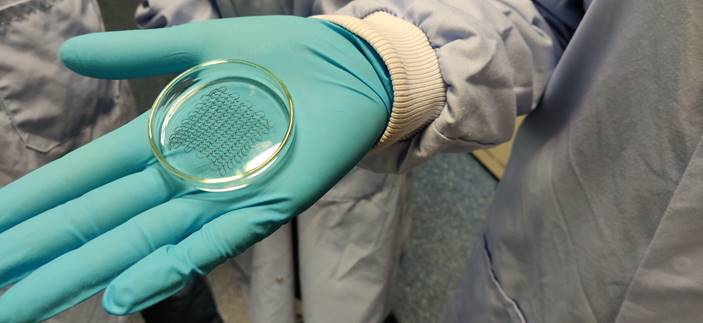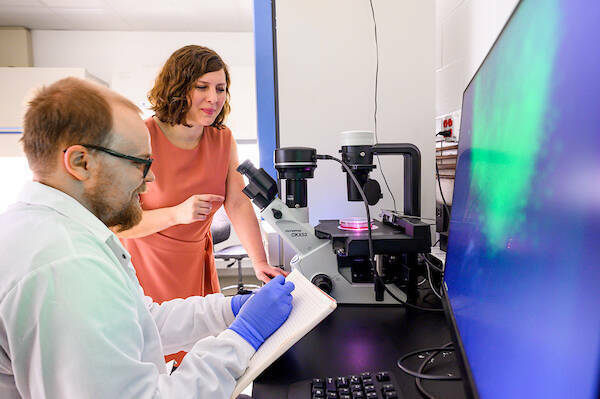via Trinity College Dublin
Bioengineers from Trinity have developed a prototype patch that does the same job as crucial aspects of heart tissue.
Their patch withstands the mechanical demands and mimics the electrical signalling properties that allow our hearts to pump blood rhythmically round our bodies. Their work essentially takes us one step closer to a functional design that could mend a broken heart.
One in six men and one in seven women in the EU will suffer a heart attack at some point in their lives. Worldwide, heart disease kills more women and men – regardless of race, than any other disease.
Cardiac patches lined with heart cells can be applied surgically to restore heart tissue in patients who have had damaged tissue removed after a heart attack and to repair congenital heart defects in infants and children.
Ultimately, though, the goal is to create cell-free patches that can restore the synchronous beating of the heart cells, without impairing the heart muscle movement.
Michael Monaghan, ussher assistant professor in biomedical engineering at Trinity, and senior author on the paper, said:
“Despite some advances in the field, heart disease still places a huge burden on our healthcare systems and the life quality of patients worldwide. It affects all of us either directly or indirectly through family and friends. As a result, researchers are continuously looking to develop new treatments which can include stem cell treatments, biomaterial gel injections and assistive devices.”
“Ours is one of few studies that looks at a traditional material, and through effective design allows us to mimic the direction-dependent mechanical movement of the heart, which can be sustained repeatably. This was achieved through a novel method called ‘melt electrowriting’ and through close collaboration with the suppliers located nationally we were able to customise the process to fit our design needs.”
This work was performed in the Trinity Centre for Biomedical Engineering, based in the Trinity Biomedical Sciences Institute in collaboration with Spraybase®, a subsidiary of Avectas Ltd. It was funded by Enterprise Ireland through the Innovation Partnership Program (IPP).
Dr Gillian Hendy, director of Spraybase® is a co-author on the paper. Dr Hendy commended the team at Trinity on the work completed and advancements made on the Spraybase® Melt Electrowriting (MEW) System.
The success achieved by the team highlights the potential applications of this novel technology in the cardiac field and succinctly captures the benefits of industry and academic collaboration, through platforms such as the IPP.
The Latest Updates from Bing News & Google News
Go deeper with Bing News on:
Heart patch
- The Peanut Patch, newest addition to county’s retail landscape
A ribbon-cutting ceremony and open house was held May 3 to celebrate the opening of The Peanut Patch gift shop, located within B & B Discount Drugs in Luverne.
- HealthWatch: Fixing a hole in your heart
A pounding headache and slurred speech sent Brian Holewinski to the emergency room in 2011. “(My wife) woke me up. When she walked into the bedroom, she told ...
- WoW Dragonflight Dark Heart Patch Notes
The Dark Heart content update for World of Warcraft Dragonflight has arrived, bringing a prologue to The War Within, heritage armor for Draenei and Trolls, a ...
- Nikki DeLoach Has Her Heart Set on a New Holiday Hallmark Movie With Andrew Walker: What We Know
Nikki DeLoach is excited to be working with Andrew Walker on Hallmark’s Curious Caterer Mysteries franchise — but she’s ready to reunite for a holiday feature.
- Charlotte officer remembered as hard-charging cop with soft heart for his family
Some of Eyer's peers and loved ones, including his wife, best friend Charlie Sardelli and fellow CMPD officers Nicholas Ferriera and Detective Thomas Mattox spoke at the service. They described Eyer ...
Go deeper with Google Headlines on:
Heart patch
[google_news title=”” keyword=”heart patch” num_posts=”5″ blurb_length=”0″ show_thumb=”left”]
Go deeper with Bing News on:
Artificial heart tissue
- Is Nicole Shanahan the Most Dangerous Woman in America?
The ex-wife of Google’s Sergey Brin poured divorce money into Robert F. Kennedy Jr.’s campaign and became his running mate, with potentially cataclysmic consequences.
- Artificial Intelligence
By Erica L. Green The prominent A.I. start-up is also joining an industrywide effort to spot content made with artificial intelligence. By Cade Metz and Tiffany Hsu The suit, which accuses the ...
- The first blueprint for building an artificial ovary
With greater insight into the developmental process of follicles, the team is hopeful that they will be able to trigger cells into maturity and produce optimized artificial ovarian tissue, which can ...
- Yale researchers are bioengineering blood vessels to treat congenital heart defects
They have begun designing an artificial blood vessel to grow in a patient’s heart. After receiving over $2 million from ... to get actually enough … cells that are required to engineer tissue and ...
- Artificial heart boy recovers
The youngest ever person to receive an artificial heart implant has had it removed when his own heart started working again. Sixteen-year-old Jamie Darney from Port Talbot in south Wales was given ...
Go deeper with Google Headlines on:
Artificial heart tissue
[google_news title=”” keyword=”artificial heart tissue” num_posts=”5″ blurb_length=”0″ show_thumb=”left”]











